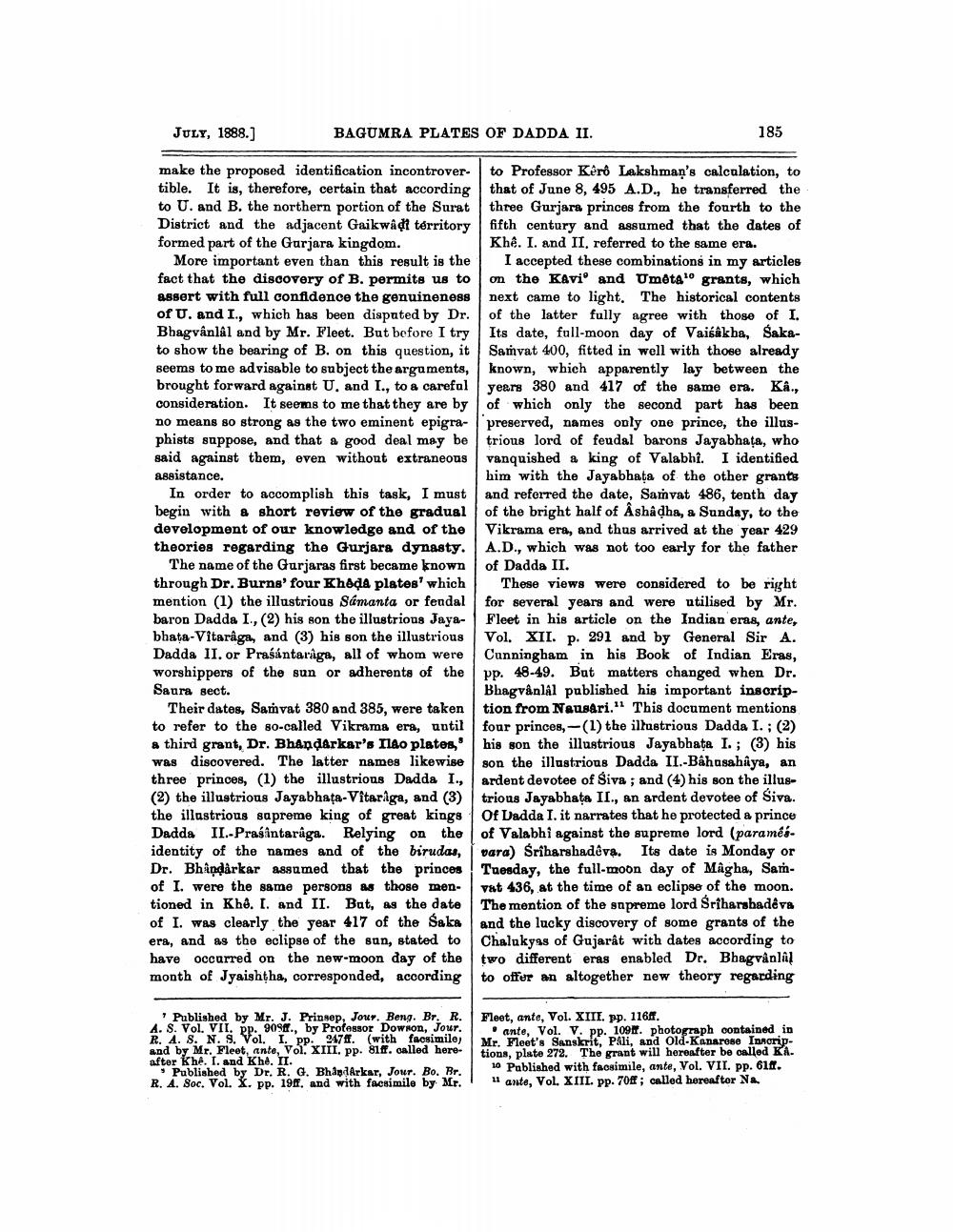________________
JULY, 1888.]
BAGUMRA PLATES OF DADDA II.
185
make the proposed identification incontroverto Professor Kêrê Lakshman's calculation, to tible. It is, therefore, certain that according that of June 8, 495 A.D., he transferred the to U. and B. the northern portion of the Surat three Gurjara princes from the fourth to the District and the adjacent Gaikwad? territory fifth century and assumed that the dates of formed part of the Garjara kingdom.
Khê. I. and II. referred to the same era. More important even than this result is the | I accepted these combinations in my articles fact that the discovery of B. permits us to on the Kavio and Umétato grants, which assert with full confidence the genuineness next came to light. The historical contents of U. and I., which has been dispated by Dr. of the latter fully agree with those of I. Bhagvânlâl and by Mr. Fleet. But before I try Its date, full-moon day of Vaisakba, Sakato show the bearing of B. on this question, it Samvat 400, fitted in well with those already seems to me advisable to subject the arguments, known, which apparently lay between the brought forward against U, and I., to a careful years 380 and 417 of the same era. Ka., consideration. It seems to me that they are by of which only the second part has been no means so strong as the two eminent epigra- preserved, names only one prince, the illusphists suppose, and that a good deal may be trious lord of feudal barons Jayabhata, who said against them, even without extraneous vanquished a king of Valabhi. I identified assistance.
him with the Jayabhata of the other grants In order to accomplish this task, I must and referred the date, Sarvat 486, tenth day begin with a short review of the gradual of the bright half of Ashâdha, a Sunday, to the development of our knowledge and of the Vikrama era, and thus arrived at the year 429 theories regarding the Gurjara dynasty. A.D., which was not too early for the father
The name of the Gurjaras first became known of Dadda II. through Dr. Burns' four Khoda plates' which These views were considered to be right mention (1) the illustrious Samanta or fendal for several years and were utilised by Mr. baron Dadda I., (2) his son the illustrious Jaya- Fleet in his article on the Indian eras, ante, bhata-Vitarâga, and (3) his son the illustrious Vol. XII. p. 291 and by General Sir A. Dadda II. or Praśántarága, all of whom were Cunningham in his Book of Indian Eras, worshippers of the sun or adherents of the pp. 48-49. But matters changed when Dr. Saura sect.
Bhagvånlal published his important inscripTheir dates, Samvat 380 and 385, were taken tion from Nausari." This document mentions to refer to the so-called Vikrama era, antil four princes -(1) the illustrious Dadda I. ; (2) a third grant, Dr. Bhandarker's Ildo plates, his son the illustrious Jayabhata I. ; (3) his was discovered. The latter names likewise son the illustrious Dadda II.-Bahasahiya, an three princes, (1) the illustrions Dadda I., ardent devotee of Siva ; and (4) his son the illus(2) the illustrious Jayabhata-Vitaraga, and (3) trious Jayabhata II., an ardent devotee of Siva. the illustrious sapreme king of great kings Of Dadda I. it narrates that he protected a prince Dadda II.-Prasantarâga. Relying on the of Valabhi against the supreme lord (paramés. identity of the names and of the birudas, vara) Sriharshadêva. Its date is Monday or Dr. Bhindarkar assumed that the princes ! Tuesday, the full-moon day of Magha, Samof I. were the same persons as those men- vat 436, at the time of an eclipse of the moon. tioned in Khê. I. and II. Bat, as the date The mention of the sapreme lord Sriharsbadeva of I. was clearly the year 417 of the Saka and the lucky discovery of some grants of the era, and as the eclipse of the sun, stated to Chalukyus of Gujarât with dates according to have occurred on the new-moon day of the two different eras enabled Dr. Bhagvanlal month of Jyaishtha, corresponded, according to offer an altogether new theory regarding
Published by Mr. J. Prinsep, Jour. Beng. Br. R. A. $. Vol. VII. pp. 9o9ff., by Professor Dowron, Jour. R. A. S. N. S. Vol. I. pp. 247ff. (with facsimile) and by Mr. Fleet, ante, Vol. XIII, pp. 81ff. called hereafter khe. I. and Khe. II.
Published by Dr. R. G. Bhandarkar, Jour. Bo. Br. R. A. Soc. Vol. X. pp. 19ff, and with facsimile by Mr.
Fleet, ante, Vol. XIII. pp. 11688.
ante, Vol. V. pp. 109. photograph contained in Mr. Fleet's Sanskrit, Páli, and Old-Kanarose Inscriptions, plate 272. The grant will hereafter be oallod KA. 10 Published with facsimile, ante, Vol. VII. PP. 618.
ante, Vol. XIII. pp. 70ff; called hereaftor Na.




